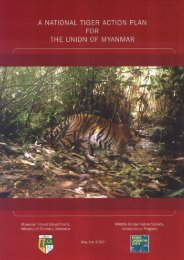Download - Global Tiger Initiative
Download - Global Tiger Initiative
Download - Global Tiger Initiative
You also want an ePaper? Increase the reach of your titles
YUMPU automatically turns print PDFs into web optimized ePapers that Google loves.
a physically harsh environment, Snow Leopards in these circumstances are most likely to<br />
benefit from supportive schemes designed to protect local human livelihoods also.<br />
Decline in availability of wild prey is coupled with intentional killing as a foremost threat to the<br />
species. Populations of wild ungulates, such as Blue Sheep, Argali and Siberian Ibex, which<br />
form an important part of the Snow Leopard's natural prey, have decreased in recent years.<br />
Habitat fragmentation and accidental killing (by traps or poison laid for other animals) are<br />
subsidiary threats, but to a greater or lesser degree, the various threats to Snow Leopards are<br />
inter-related.<br />
Loss of wild prey can be caused through degradation of ungulate habitat, mostly caused by overgrazing<br />
of domestic livestock and by unmanaged hunting of ungulates, mainly for subsistence,<br />
and of other prey species by humans. These circumstances can lead Snow Leopards to take<br />
domestic animals for their prey and such incidences are often reported from areas where<br />
populations of wild ungulates have decreased. This predation on domestic livestock leads to<br />
conflict between herders and Snow Leopards and, as such, the lack of natural prey poses both a<br />
direct and indirect threat to the animals.<br />
Killings by herders in retaliation for, or in prevention of, livestock depredation are seen as the<br />
prime threat to Snow Leopards in Bhtuan, India and Nepal, and such conflict with herders is<br />
probably the first reason for Snow Leopard killings in Mongolia. This type of threat is also<br />
considerable in Afghanistan, Pakistan and the Himalayan region of China. For herders, the<br />
effect of losing livestock to Snow Leopards can be devastating, sometimes amounting to the<br />
equivalent of up to 20% of the household’s annual income. The result is that herding<br />
communities affected by predatory attacks feel completely justified in ridding themselves of<br />
local Snow Leopards.<br />
Even in those countries where protection of livestock is a paramount concern, an awareness of<br />
the potential income to be gained from Snow Leopard parts means that these enter trade, even<br />
though this was not the primary incentive for killing. The value of a Snow Leopard skin is<br />
relatively high and, in some instances, can be equivalent to the annual income of a herder<br />
family.<br />
Killing Snow Leopards for trade is considered the main threat to the species in the Russian<br />
Federation and Kyrgyzstan, and this is probably the prime threat in Kazakhstan, Tajikistan and<br />
Uzbekistan. Although killing Snow Leopards in defence of domestic stock is reported from<br />
Uzbekistan and from the Tyva Republic in the Russian Federation, this threat is generally less<br />
significant to the species in the central Asian part of its range, than in the Himalayan region.<br />
Whether killed to protect livestock, for financial gain, or for a mixture of these motives, Snow<br />
Leopards are traded in all range States, with the exception of Bhutan, for which no information<br />
on this subject was available.<br />
Although it is difficult to assess the overall numbers of Snow Leopards killed each year for<br />
trade, the information compiled in this report provides real cause for concern. A sharp rise in<br />
Snow Leopard hunting for trade during the last decade of the twentieth century is reported,<br />
especially from the central Asian range States and Russian Federation. This is largely attributable<br />
to the collapse of law and order and the financial insecurity following in the wake of the<br />
dissolution of the Soviet Union and expanded market possibilities in East Asia and the Russian<br />
Federation. The result has been unchecked targeting of Snow Leopards, as a source of income,<br />
54 FADING FOOTPRINTS: the killing and trade of Snow Leopards

















